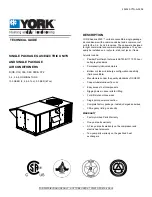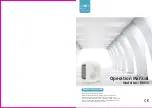
After the refrigerant pipe is installed and before the refrigerant pipe
is connected to an ODU, inject nitrogen at a certain pressure and at
the same time from both gas and liquid sides (for the R410A
refrigerant model, inject 40 kgf/cm2 nitrogen (at 3.9 MPa)) for a
24-hour air tightness test.
Connect the refrigerant pipe to the gas side and liquid side of the
ODU. Use a vacuum pump to vacuumize the gas side and liquid
side of the ODU.
Turn on/off the valve core of the ODU by using a 5 mm hex wrench.
If the one-way pipe length is less than 5 m (including 5 m), the
refrigerant charging amount is determined according to the
nameplate.
If the one-way pipe length exceeds 5 m, the supplementary
refrigerant charging amount should be calculated according to
the pipe diameter and length of the liquid-side pipes of the IDU
and ODU. See the table below for details.
Record the amount of refrigerant charged and retain the record
for use during future maintenance.
Supplementary
Refrigerant Amount
Remarks
L is the one-way
pipe length
L is the one-way
pipe length
Diameter of
Liquid-side Pipe
0.0115 kg (L-5)
0.027 kg (L-5)
Model
53/71
90/105/120
/140/160
The refrigerant sealed into the ODU must not be used for
vacuumizing.
Do not let air, dust, or other particles invade the pipeline
system during installation of the connecting pipes.
Install the connecting pipes only when the indoor and outdoor
units are secured.
Make sure to keep the connecting pipes dry during installation
so that no water will enter the piping system.
Connecting copper pipes must be wrapped with insulation
materials (thicker than 10 mm, the thickness should be
increased if the unit is installed in a closed humid place).
NOTE
Depending on the installation conditions, excessive torque will
damage the pipe socket, while inadequate torque will cause air
leakage. Refer to the following table to determine the tightening
torque.
1. Bend the pipe or drill a hole in the wall as needed. The
cross-sectional area of the pipe bending deformation must not
exceed 1/3 of the original pipe section. A protective casing should
be provided at the wall or floor hole. The weld joint must not be
inside the casing. The drill hole on the external wall must be sealed
and tightly wrapped with a binding tie to prevent impurities from
entering the pipe. The pipe must be insulated with an insulation pipe
of suitable size.
2. Insert the bundled piping and wiring from outside the room
through the wall opening into the room. Be careful when laying out
the pipes. Do not damage them.
After completing the above steps, the check valve stem of the ODU
should be fully opened to ensure that the refrigerant pipeline of the
IDU and ODU is unobstructed.
Use a leak detector or soapy water to carefully check for leakage
and ensure that there is no leakage. Cover the joint of the IDU with
a sound/heat insulation sleeve (accessory) and wrap it tightly with a
binding tie to prevent condensation and water leakage.
1. Flaring
2. Insert the pipe into the connection nut flare.
Align the connection pipe, tighten the
connecting nut with a hand, and tighten
them with a wrench as shown in the right
figure.
Use a pipe cutter to cut off the pipe, and rotate the pipe cutter
repeatedly to cut off the pipe.
If a copper pipe purchased from the market is used, the heat
insulation material of the copper pipe must be the same (thicker
than 10mm, the thickness should be increased if the unit is installed
in a closed humid place).
Method of unwinding the coil:
Straighten the pipe end
Pipe cutter
Rough
Slope
Burrs
90 degrees
Outer diameter
(mm)
Max.
Min.
A (mm)
8.7
12.4
15.8
8.3
12.0
15.4
19.0
18.6
23.3
22.9
90 degrees ± 4
R0.4~0.8
A
Pipe size
Tightening torque N.m
14.2 17.2 N.m (144 176 kgf.cm)
32.7 39.9 N.m (333 407 kgf.cm)
49.5 60.3 N.m (504 616 kgf.cm)
61.8 75.4 N.m (630 770 kgf.cm)
97.2 118.6 N.m (990 1210 kgf.cm)
CAUTION
CAUTION
10
































